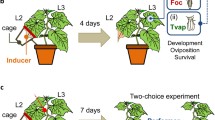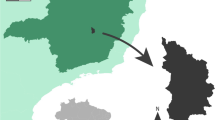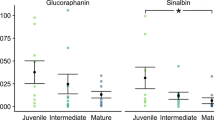Abstract
Many herbivores elicit biochemical, physiological, or morphological changes in their host plants that render them more resistant to co-occurring herbivores. Yet, despite the large number of studies that investigate how induced resistance affects herbivore preference and performance, very few have simultaneously explored the cascading effects of induction on higher trophic levels and consequences for prey suppression. In our study system, early-season herbivory by leafhoppers elevated plant resistance to subsequent attack by chrysomelid beetles sharing the same host plant. Notably, beetles feeding on leafhopper-damaged plants incurred developmental penalties (e.g., prolonged time in early larval instars) that rendered them more susceptible to predation by natural enemies. As a result, the combined bottom-up effect of leafhopper-induced resistance and the top-down effect of enhanced predation resulted in the synergistic suppression of beetle populations. These results emphasize that higher trophic level dynamics should be considered in conjunction with induced resistance to better understand how plants mediate interspecific interactions in phytophagous insect communities.





Similar content being viewed by others
References
Agrawal AA, Tuzun S, Bent E (1999) Inducible plant defenses against pathogens and herbivores: biochemistry, ecology, and agriculture. American Phytopathological Society Press, St Paul, Minn.
Backus EA, Serrano MS, Ranger CM (2005) Mechanisms of hopperburn: an overview of insect taxonomy, behavior, and physiology. Annu Rev Entomol 50:125–151
Benrey B, Denno RF (1997) The slow-growth-high-mortality hypothesis: a test using the cabbage butterfly. Ecology 78:987–999
Bergelson JM, Lawton JH (1988) Does foliage damage influence predation on the insect herbivores of birch? Ecology 69:434–445
Biever KD, Chauvin RL (1992) Suppression of the Colorado potato beetle (Coleoptera: Chrysomelidae) with augmentative releases of predaceous stinkbugs (Hemiptera: Pentatomidae). J Econ Entomol 85:720–726
Boege K (2004) Induced responses in three tropical dry forest plant species—direct and indirect effects on herbivory. Oikos 107:541–548
Cañas LA, O’Neil RJ, Gibb TJ (2002) Population ecology of Leptinotarsa decemlineata Stål (Coleoptera: Chrysomelidae): population dynamics, mortality factors, and potential natural enemies for biological control of the Colorado potato beetle. Biol Control 24:50–64
Cappaert DL, Drummond FA, Logan PA (1991) Population dynamics of the Colorado potato beetle (Coleoptera: Chrysomelidae) on a native host in Mexico. Environ Entomol 20:1549–1555
Cloutier C, Bauduin F (1995) Biological control of the Colorado potato beetle Leptinotarsa decemlineata (Coleoptera: Chrysomelidae) in Quebec by augmentative releases of the two-spotted stinkbug Perillus bioculatus (Hemiptera: Pentatomidae). Can Entomol 127:195–212
Denno RF, Kaplan I (2007) Plant-mediated interactions in herbivorous insects: mechanisms, symmetry, and challenging the paradigms of competition past. In: Ohgushi T, Craig TP, Price PW (eds) Ecological communities: plant mediation in indirect interaction webs. Cambridge University Press, Cambridge, pp 19–50
Denno RF, McClure MS, Ott JR (1995) Interspecific interactions in phytophagous insects: competition revisited and resurrected. Annu Rev Entomol 40:297–331
Denno RF, Gratton C, Peterson MA, Langellotto GA, Finke DL, Huberty AF (2002) Bottom-up forces mediate natural-enemy impact in a phytophagous insect community. Ecology 83:1443–1458
Edwards PJ, Wratten SD, Gibberd RM (1991) The impact of inducible phytochemicals on food selection by insect herbivores and its consequences for the distribution of grazing damage. In: Tallamy DW, Raupp MJ (eds) Phytochemical induction by herbivores. Wiley, New York, pp 205–221
Engelberth J, Alborn HT, Schmelz EA, Tumlinson JH (2004) Airborne signals prime plants against insect herbivore attack. Proc Natl Acad Sci 101:1781–1785
Erickson KS, Morse DH (1997) Predator size and the suitability of a common prey. Oecologia 109:608–614
Faeth SH (1994) Induced plant responses: effects on parasitoids and other natural enemies of phytophagous insects. In: Hawkins BA, Sheehan W (eds) Parasitoid community ecology. Oxford University Press, New York, pp 245–260
Forkner RE, Hunter MD (2000) What goes up must come down? Nutrient addition and predation pressure on oak herbivores. Ecology 81:1588–1600
Häggström H, Larsson S (1995) Slow larval growth on a suboptimal willow results in high predation mortality in the leaf beetle Galerucella lineola. Oecologia 104:308–315
Hare JD (1990) Ecology and management of the Colorado potato beetle. Annu Rev Entomol 35:81–100
Hare JD (1992) Effects of plant variation on herbivore–natural enemy interactions. In: Fritz RS, Simms EL (eds) Plant resistance to herbivores and pathogens: ecology, evolution and genetics. University of Chicago Press, Chicago, Ill., pp 278–298
Hare JD (2002) Plant genetic variation in tritrophic interactions. In: Tscharntke T, Hawkins BA (eds) Multitrophic level interactions. Cambridge University Press, New York, pp 8–43
Havill NP, Raffa KF (2000) Compound effects of induced plant responses on insect herbivores and parasitoids: implications for tritrophic interactions. Ecol Entomol 25:171–179
Heidel AJ, Baldwin IT (2004) Microarray analysis of salicylic acid- and jasmonic acid-signaling in responses of Nicotiana attenuata to attack by insects from multiple feeding guilds. Plant Cell Environ 27:1362–1373
Heil M, Kost C (2006) Priming of indirect defences. Ecol Lett 9:813–817
Hough-Goldstein JA (1998) Use of predatory pentatomids in integrated management of the Colorado potato beetle (Coleoptera: Chrysomelidae). In: Coll M, Ruberson JR (eds) Predatory Heteroptera: their ecology and use in biological control. Say, Lanham, pp 209–223
Hunter MD (1992) Interactions within herbivore communities mediated by the host plant: the keystone herbivore concept. In: Hunter MD, Ohgushi T, Price PW (eds) Effect of resource distribution on plant–animal interactions. Academic Press, San Diego, Calif., pp 287–325
Hunter MD, Price PW (1992) Playing chutes and ladders: heterogeneity and the relative roles of bottom-up and top-down forces in natural communities. Ecology 73:724–732
Hunter MD, Schultz JC (1993) Induced plant defenses breached? Phytochemical induction protects an herbivore from disease. Oecologia 94:195–203
Hunter MD, Varley GC, Gradwell GR (1997) Estimating the relative roles of top-down and bottom-up forces on insect herbivore populations: a classic study revisited. Proc Natl Acad Sci USA 94:9176–9181
Kaitaniemi P, Vehviläinen H, Ruohomäki K (2004) Movement and disappearance of mountain birch defoliators are influenced by the interactive effects of plant architecture and induced resistance. Ecol Entomol 29:437–446
Karban R, Baldwin IT (1997) Induced responses to herbivory. University of Chicago Press, Chicago, Ill.
Kay AD, Scott SE, Schade JD, Hobbie SE (2004) Stoichiometric relations in an ant–treehopper mutualism. Ecol Lett 7:1024–1028
Kessler A, Baldwin IT (2004) Herbivore-induced plant vaccination. Part I. The orchestration of plant defenses in nature and their fitness consequences in the wild tobacco Nicotiana attenuata. Plant J 38:639–649
Lill JT, Marquis RJ (2001) The effects of leaf quality on herbivore performance and attack from natural enemies. Oecologia 126:418–428
Lill JT, Marquis RJ, Ricklefs RE (2002) Host plants influence parasitism of forest caterpillars. Nature 417:170–173
Loader C, Damman H (1991) Nitrogen content of food plants and vulnerability of Pieris rapae to natural enemies. Ecology 72:1586–1590
Lynch ME, Kaplan I, Dively GP, Denno RF (2006) Host-plant-mediated competition via induced resistance: interactions between pest herbivores on potatoes. Ecol Appl 16:855–864
Marquis RJ, Whelan CJ (1996) Plant morphology and recruitment of the third trophic level: subtle and little-recognized defenses? Oikos 75:330–333
Moran N, Hamilton WD (1980) Low nutritive quality as defense against herbivores. J Theor Biol 86:247–254
Ode PJ (2006) Plant chemistry and natural enemy fitness: effects on herbivore and natural enemy interactions. Annu Rev Entomol 51:163–185
Ohgushi T (2005) Indirect interaction webs: herbivore-induced effects through trait change in plants. Annu Rev Ecol Evol Syst 36:81–105
Olmstead KL, Denno RF, Morton TC, Romeo JT (1997) Influence of Prokelisia planthoppers on the amino acid composition and growth of Spartina alterniflora. J Chem Ecol 23:303–321
Paré PW, Lewis WJ, Tumlinson JH (1999) Induced plant volatiles: biochemistry and effects on parasitoids. In: Agrawal AA, Tuzun S, Bent E (eds) Inducible plant defenses against pathogens and herbivores: biochemistry, ecology, and agriculture. American Phytopathological Society Press, St Paul, Minn., pp 167–180
Price PW, Bouton CE, Gross P, McPheron BA, Thompson JN, Weis AE (1980) Interactions among three trophic levels: influence of plants on interactions between insect herbivores and natural enemies. Annu Rev Ecol Syst 11:41–65
Raven JA (1983) Phytophages of xylem and phloem: a comparison of animal and plant sap-feeders. Adv Ecol Res 13:135–234
Rodriguez-Saona C, Thaler JS (2005) The jasmonate pathway alters herbivore feeding behaviour: consequences for plant defences. Entomol Exp Appl 115:125–134
Schultz JC (1983) Habitat selection and foraging tactics of caterpillars in heterogeneous trees. In: Denno RF, McClure MS (eds) Variable plants and herbivores in natural and managed systems. Academic Press, New York, pp 61–90
Sih A, Englund G, Wooster D (1998) Emergent impacts of multiple predators on prey. Trends Ecol Evol 13:350–355
Stiling P, Rossi AM (1997) Experimental manipulations of top-down and bottom-up factors in a tri-trophic system. Ecology 78:1602–1606
Takabayashi J, Dicke M (1996) Plant-carnivore mutualism through herbivore-induced carnivore attractants. Trends Plant Sci 1:109–113
Thaler JS (2002) Effect of jasmonate-induced plant responses on the natural enemies of herbivores. J Anim Ecol 71:141–150
Tomlin ES, Sears MK (1992) Indirect competition between the Colorado potato beetle (Coleoptera: Chrysomelidae) and the potato leafhopper (Homoptera: Cicadellidae) on potato: laboratory study. Environ Entomol 21:787–792
Turlings TCJ, Benrey B (1998) Effects of plant metabolites on the behavior and development of parasitic wasps. Ecoscience 5:321–333
Van der Meijden E, Klinkhamer GL (2000) Conflicting interests of plants and the natural enemies of herbivores. Oikos 89:202–208
Van Loon JJA, de Vos EW, Dicke M (2000) Orientation behaviour of the predatory hemipteran Perillus bioculatus to plant and prey odours. Entomol Exp Appl 96:51–58
Van Zandt PA, Agrawal AA (2004) Community-wide impacts of herbivore-induced plant responses in milkweed (Asclepias syriaca). Ecology 85:2616–2629
Viswanathan DV, Narwani AJT, Thaler JS (2005) Specificity in induced plant responses shapes patterns of herbivore occurrence on Solanum dulcamara. Ecology 86:886–896
Voelckel C, Weisser WW, Baldwin IT (2004) An analysis of plant-aphid interactions by different microarray hybridization strategies. Mol Ecol 13:3187–3195
Walgenbach JF, Wyman JA (1985) Potato leafhopper (Homoptera: Cicadellidae) feeding damage at various potato growth stages. J Econ Entomol 78:671–675
Walling LL (2000) The myriad plant responses to herbivores. J Plant Growth Regul 19:195–216
Weissbecker B, Van Loon JJA, Dicke M (1999) Electroantennogram responses of a predator, Perillus bioculatus, and its prey, Leptinotarsa decemlineata, to plant volatiles. J Chem Ecol 25:2313–2325
Weissbecker B, Van Loon JJA, Posthumus MA, Bouwmeester HJ, Dicke M (2000) Identification of volatile potato sesquiterpenoids and their olfactory detection by the two-spotted stinkbug Perillus bioculatus. J Chem Ecol 26:1433–1445
Williams IS (1999) Slow-growth, high-mortality—a general hypothesis, or is it? Ecol Entomol 24:490–495
Acknowledgements
We thank Heather Harmon, Amy Miller, and Terry Patton for their assistance with field experiments. Later drafts of the manuscript were greatly improved by comments from Andre Kessler, Shannon Murphy, and Gina Wimp. Funding for this research was provided by a USDA Competitive Research Grant (NRICGP, Entomology and Nematology, 00-35302-9334) to R. F. Denno and G. P. Dively. These experiments comply with the current laws of the USA.
Author information
Authors and Affiliations
Corresponding author
Additional information
Communicated by Richard Karban.
Rights and permissions
About this article
Cite this article
Kaplan, I., Lynch, M.E., Dively, G.P. et al. Leafhopper-induced plant resistance enhances predation risk in a phytophagous beetle. Oecologia 152, 665–675 (2007). https://doi.org/10.1007/s00442-007-0692-4
Received:
Accepted:
Published:
Issue Date:
DOI: https://doi.org/10.1007/s00442-007-0692-4




